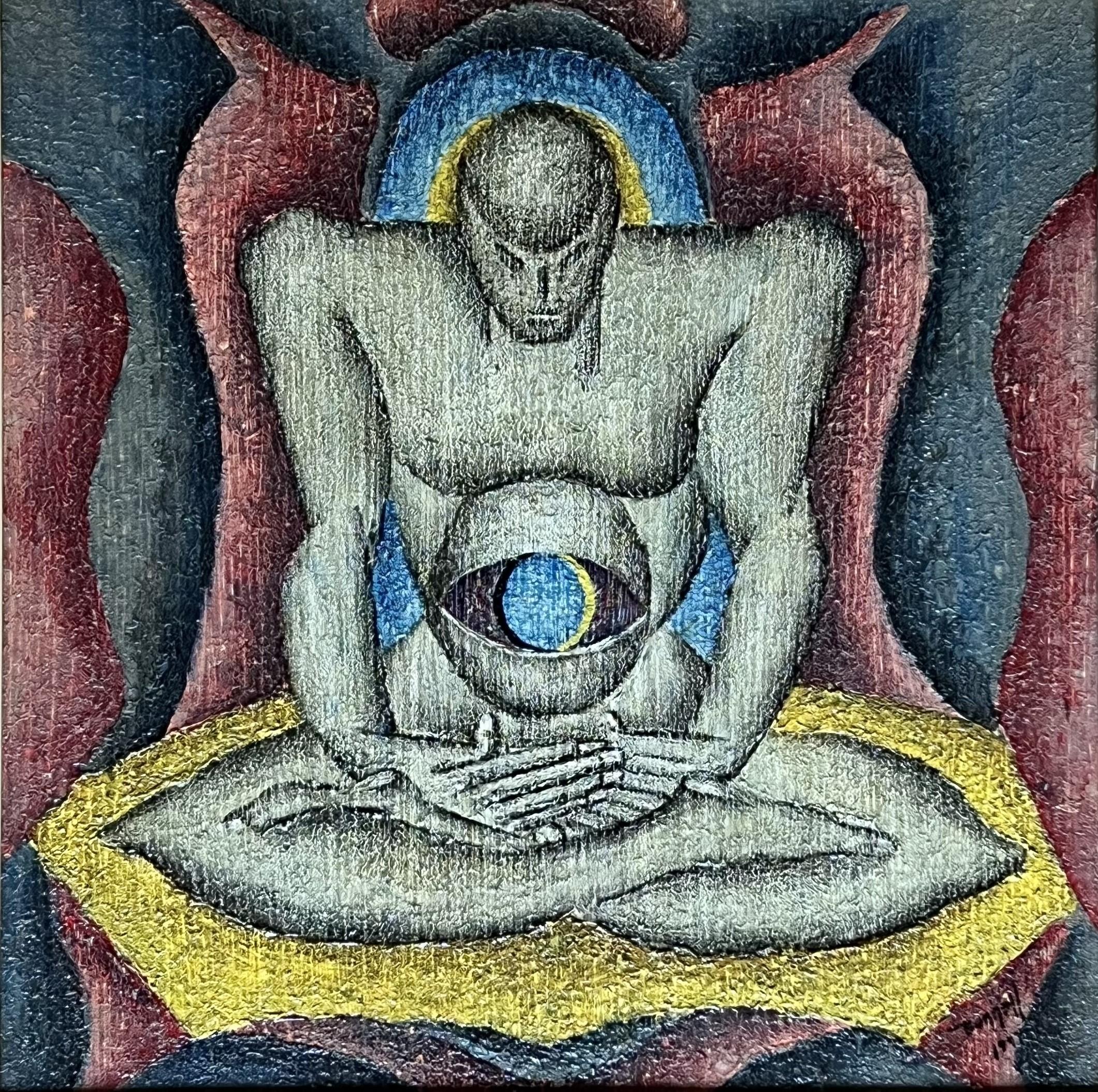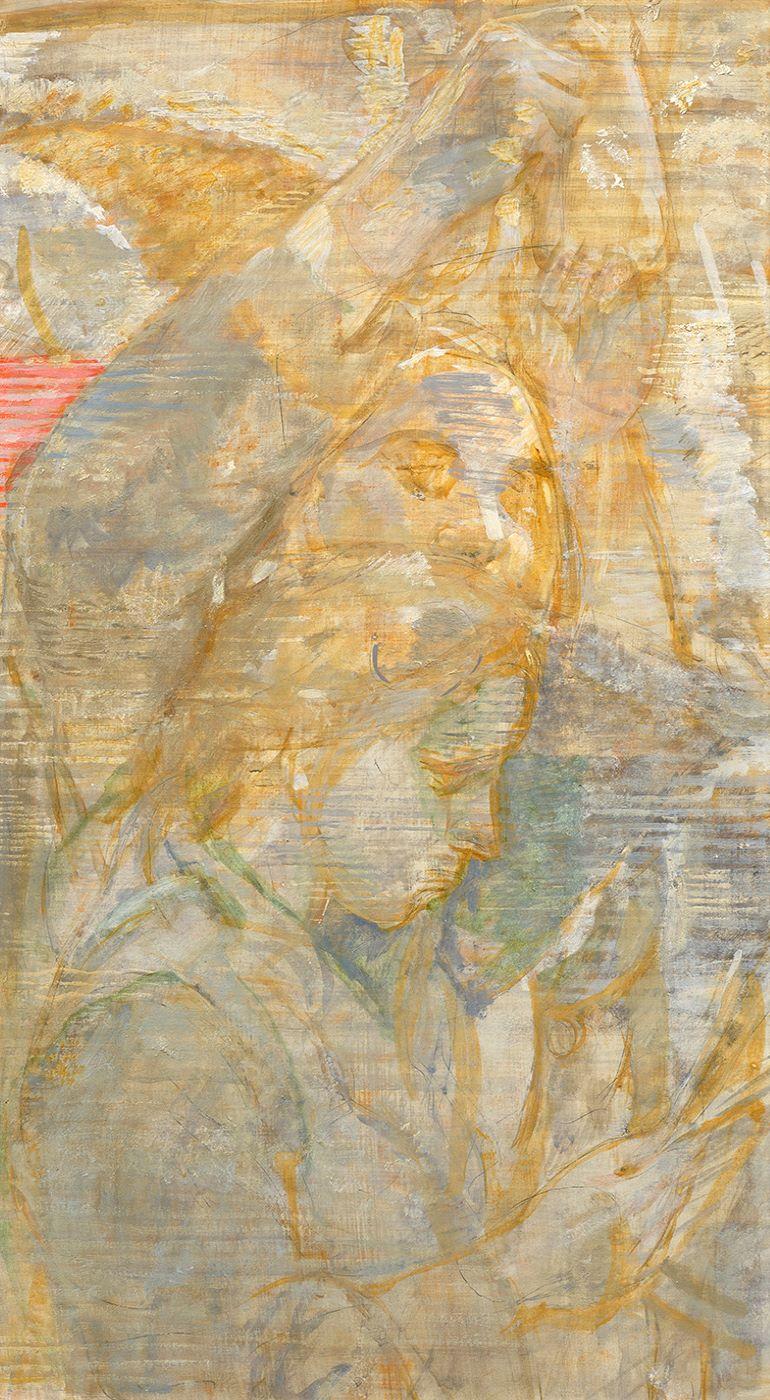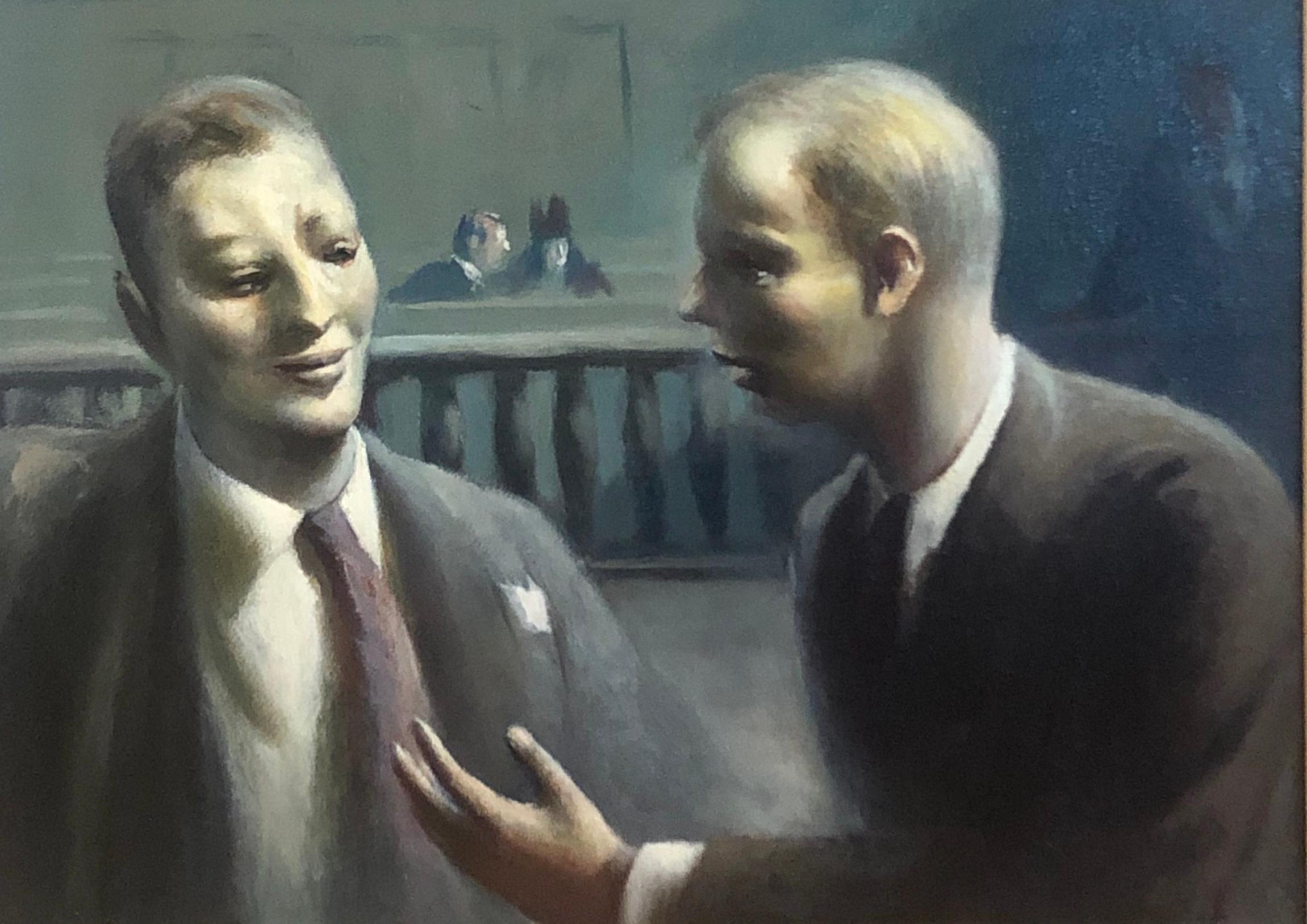Items Similar to Modern Dance Female Dancer in Red Dress Jazz - oil paint on board circa 1950s
Want more images or videos?
Request additional images or videos from the seller
1 of 9
Raimondo PuccinelliModern Dance Female Dancer in Red Dress Jazz - oil paint on board circa 1950sCirca 1950s
Circa 1950s
About the Item
Signed lower right
Raimondo (Raymond) Puccinelli (American, 1904-1986).
Puccinelli began art training at age 15 at the California School of Fine Art (now the San Francisco Art Institute) and the Schaeffer School of Design. While in Italy in 1927, he studied ancient Italian sculpture (Romanesque, Gothic, and late Renaissance) which affected his future work. After a year of studying in France and Italy with various craftsmen, he returned to San Francisco to assist in the studio of J. Vieira and study under Benny Bufano. During the decade 1930-40, he was most influenced by Mexican artist Diego Rivera. In the 1940s he maintained a studio in San Francisco's Chinatown at 15 Hotaling Place and taught sculpture at both UC Berkeley and Mills College in Oakland. He continued teaching at those schools until 1948 when he moved to Flushing, NY to teach at Queen's College. He later taught in Baltimore at the Rinehart School of Sculpture until 1960. He then moved to Florence, Italy where he remained until his death in May 1986. His work, mostly in bronze, was a link between older figurative sculptors such as Rodin and the new figuratives of the post-abstract period. He also worked in unglazed terra cotta, wood, and stone. Excerpts from his autobiographical notes: It was a veritable pleasure to know Henri Matisse whose genuinely elegant personality impressed me. He spent a short time in San Francisco on a trip, which he was making to Tahiti. After a brief meeting with me he invited himself to my studio. In a rather humorous fashion I said that I should think that he saw enough art in Paris. His reply – that he was particularly interested because I was a young sculptor and he too considered himself a sculptor (something which I did not realize) having spent eight years of work under Rodin and Bourdelle. He seemed not too pleased to be known only as a painter. The next day he was promptly at my studio. He looked carefully at all of my work – some pieces in clay were not finished and were covered over with damp cloths which he insisted on seeing also. This made me slightly embarrassed as the works were not ready for viewing. Finally he made the remark that he had been wondering. “Where are all of the men in American Art? Where are the young artists who really work and so many women in the arts and only 1/2 serious, Now I finally find one who is of the family of artists, If you were to come to Paris, you’d be one of us. Come over – and on the way stop in New York and make acquaintance with Herbert Bittner who is a lover of sculpture, - I feel that he will like your work.” Matisse talked a length about his work. He would spend a long time on a painting, turning it to the wall for many months, then taking it up again and reconsidering it. He discussed drawing. He did not feel that many critics were correct in emphasizing so very much the Near Eastern influences in his work. One point surprised me. He said that he had ardently studied and had been influenced by the drawings of Leonardo da Vinci which he said were “nature done over in a new kind of handwriting”. He spoke of finding, losing & finding again the line. – He felt that Rodin had directed him toward new paths. “You know,” he said, “that Rodin was also a colorist in his sculpture.” This discussion, parts of which come back to me from time to time, meant more to me than years of schooling. Many months later I was on my way to New York via the Indian country in the Southwest of the United States. I immediately was hard at work in a studio on 23rd Street, then moving to share a studio with a German sculptor, Carl Schmitz. It was here that Herbert Bittner came to see the work that I had been doing. Bittner, I learned, had a wide experience in the arts, especially sculpture and drawing. He had also spent some years in Rome as director of an important book store. Now director of the Westermann Gallery at Rockefeller Center, he specialized in showing works of noted European artists such as Kathe Kollwitz and Ernst Barlach, Lehmbruck, George Grosz, his emphasis being on Germans not accepted by the Hitler regime. On seeing my work, he was immediately enthusiastic and asked to exhibit my work in the gallery, that he directed. I didn’t have enough work for a one-man show (it was a large, elegant gallery), nor could I promise one in the near future as I didn’t have the capital for the castings and these works that I was doing were for bronze. Fortunately, I had worked with a Sicilian bronze caster on Long Island, Mario Scoma. He did a fine job for me and Herbert Bittner, exhibited them in a three-man show with two noted German sculptors Barlach and Lehmbruck.
- Creator:Raimondo Puccinelli (American)
- Creation Year:Circa 1950s
- Dimensions:Height: 36 in (91.44 cm)Width: 24.75 in (62.87 cm)
- Medium:
- Movement & Style:
- Period:
- Condition:
- Gallery Location:Rancho Santa Fe, CA
- Reference Number:1stDibs: LU51639780332
About the Seller
5.0
Vetted Seller
These experienced sellers undergo a comprehensive evaluation by our team of in-house experts.
Established in 1984
1stDibs seller since 2016
78 sales on 1stDibs
Typical response time: 1 hour
- ShippingRetrieving quote...Ships From: Rancho Santa Fe, CA
- Return PolicyThis item cannot be returned.
More From This SellerView All
- Abstract painting of People on the Beach oil on canvas circa 1950-1960 New YorkBy Aaron BerkmanLocated in Rancho Santa Fe, CAAaron Berkman (New York, 1900 - 1929) "Beach" Oil on canvas 20 x 24 inches Signed lower right: Aaron Berkman Unframed Provenance: Private collection, USA An abstract oil painting o...Category
Mid-20th Century American Modern Figurative Paintings
MaterialsCanvas, Oil
- The Party - oil on canvas - New York City town house at night - 20th centuryBy Aaron BerkmanLocated in Rancho Santa Fe, CAOil on canvas 30 x 24 inches Signed verso Not framed Provenance: Private collection, USA Aaron Berkman was born in Hartford, Connecticut where his parents had been settled since 1...Category
Mid-20th Century American Modern Figurative Paintings
MaterialsOil, Canvas
- People Lawn Bowling in Central Park New York City 1950 oil/canvas NYC blue greenBy Aaron BerkmanLocated in Rancho Santa Fe, CAAaron Berkman (1900 - 1991) “Bowling in Central Park” New York Oil on canvas 10 x 14 inches Signed and titled verso: Aaron Berkman 1950 Provenance: Private collection, USA Aaron Ber...Category
1950s American Modern Figurative Paintings
MaterialsCanvas, Oil
- Rowdy Mexican Cantina Brawl with Beer, Men, Guns & KnivesLocated in Rancho Santa Fe, CAOil on canvas board. FramedCategory
1950s Modern Figurative Paintings
MaterialsCanvas, Oil, Board
- “Traveling Together” 2012 colorful oil/board abstract surrealist Armenian ArtistBy Vatche GeuvdjelianLocated in Rancho Santa Fe, CA“Traveling Together” is a colorful, abstract, surrealist painting by Armenian artist, Vatche Geuvdjelian painted in 2012. Artist’s Statement “𝘛𝘩�...Category
2010s Surrealist Abstract Paintings
MaterialsOil, Board
- Young Seated Woman in Pink Dress & Bouquet of Flowers yellow red blue green roseBy Luigi CorbelliniLocated in Rancho Santa Fe, CALovely painting - UnframedCategory
Mid-20th Century Modern Figurative Paintings
MaterialsCanvas, Oil
You May Also Like
- Untitled (Transcendental Composition)By Charles Ragland BunnellLocated in Los Angeles, CAThis work is part of our exhibition - America Coast to Coast: Artists of the 1940s Untitled (Transcendental Composition), oil on board, 1947, oil on board, signed and dated lower r...Category
1940s American Modern Paintings
MaterialsOil, Board
- Study for Subway ReadingBy Isabel BishopLocated in New York, NYIsabel Bishop portrays two people riding on a crowded subway using bright color in her painting “Study for Subway Reading.”Category
Mid-20th Century American Modern Figurative Paintings
MaterialsBoard, Pencil, Oil
- "Tailor" WPA American Scene Social Realism Modernism Mid Century Modern FashionBy Mervin JulesLocated in New York, NY"Tailor" WPA American Scene Social Realism Modernism Mid Century Modern Fashion The board measures 9 1/2 x 15 1/2. Provenance: Mervin Jules Estate. Bio A painter, illustrator, pri...Category
1930s American Modern Figurative Paintings
MaterialsOil, Board
- "Industrial Cityscape, Chicago" WPA Modernism Mid-Century Cityscape 20th CenturyBy Aaron BohrodLocated in New York, NYMidwestern Chicago artist Aaron Bohrod painted in 1931 this modernist industrial cityscape during the WPA of the 20th Century. Aaron Bohrod (American 1907 – 1992), Industrial Citysc...Category
1930s American Modern Landscape Paintings
MaterialsOil, Board
- Guy Pene du Bois WPA American Modernism Realism NYC Scene Oil Lawyers in CourtBy Guy Pène Du BoisLocated in New York, NYGuy Pene du Bois' "Two Figures in Courtroom" is a WPA era American scene oil painting created in a realistic style. Modernism at its best The work is framed by Heydenryk. Pène du Bois descended from French immigrants who settled in Louisiana in 1738 and was raised in a Creole household. He was born in 1884 in Brooklyn, NY and first studied with William Merritt Chase at the New York School of Art and later continued his training with Robert Henri. Pène du Bois was greatly impressed with Henri's credo that "real life" was subject matter for art and throughout his life a realist philosophy informed his art as well as his parallel career, art criticism. In 1905, Pène du Bois made his first visit to Paris where he painted scenes of fashionable people in cafes rendered in the dark tonalities and impasto associated with the Ashcan School. By 1920, he had achieved his mature style, which was characterized by stylized, rounded, almost sculptural figures painted with invisible brushstrokes. The subjects of his paintings were often members of society whom he gently satirized. In 1924, Pène du Bois and his wife, Floy, left for France where they would remain until 1930. Returning to America showcases pictures the artist produced after this very productive period abroad. After five years of living in France, Pène du Bois was able to observe American life with fresh eyes. His work becomes more psychologically intense and less satirical. In Girl at Table a slender, blond is shown gazing at a small statue that she holds at arm's distance. The meaning is elusive, but a powerful sense of longing is evoked. Similarly, paintings such as Dramatic Moment and Jane are taut with unresolved dialogue. Both pictures depict mysterious interiors in which a lone woman anxiously awaits the denouement of a suspenseful scene. Other pictures, for example, Chess Tables, Washington Square and Bar, New Orleans, recall Pene du Bois's Ashcan origins in their depiction of urban entertainment. During this period, landscape becomes an important subject for Pène du Bois. Girl Sketching...Category
1930s American Modern Figurative Paintings
MaterialsPaper, Oil, Board
- Waiting for the Bus in a Blizzard- WPA American Scene 1938 NYC Modernism RealismBy Maurice KishLocated in New York, NYWaiting for the Bus in a Blizzard- WPA American Scene 1938 NYC Modernism Realism. 16 x 16 inches, Oil on board, Signed and dated 1938 lower left. ...Category
1930s American Modern Figurative Paintings
MaterialsOil, Board





